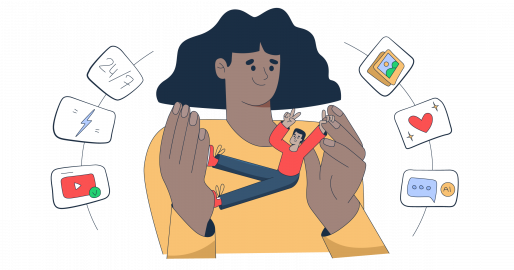What do Apple, Amazon, Netflix, and Starbucks have in common? All of them are famous for designing products that address customer needs. Most importantly, they have chatbot flows that provide an overall experience that’s easy and enjoyable for customers.
In the business world, we call it customer centricity. Each customer expects it from your company. But how does it work?
In this guide, we give you a breakdown of customer centricity, talk about its benefits and insights, and show you the best practices you can use to be more customer-centric.
What is customer centricity?
Customer centricity is a business approach that focuses on consumers’ needs and puts their interests and pain points at the center of every brand decision and action. This includes product development, marketing campaigns, sales, and communication with the support team.
For consumers, interacting with a customer-centric culture is about:
- Getting only relevant recommendations.
- Not having to repeat a problem twice to a support manager.
- Having access to a chatbot that offers 24/7 customer support.
- Getting in touch with the right customer representatives fast.
For business, to have a customer-centric culture is about:
- Ensuring every team member deeply understands what the customer needs and wants.
- Improving a product and customer service based on consumers’ feedback.
- Encouraging employees to think innovatively and develop solutions that fit customers’ needs.
- Gathering and analyzing customer data to strengthen brand positioning, personalizing the value proposition, and customer engagement/conversion strategies.
- Making the purchase process simple and easy.
- Increasing customer touchpoints.
- Providing omnichannel customer communication.
Reasons why companies want to be customer-centric
Here are four ways your business can grow by adopting a customer-driven approach.
Increasing sales
When businesses take customers’ feedback into account, clients feel heard, which builds loyalty. As a result, 68% of customers tend to spend more money, and turning from product to customer centricity can bring you 80% revenue growth.
Using sales funnel software can further streamline this process by tracking customer interactions and optimizing each stage of the buyer’s journey. All in all, this approach helps to strengthen the sales funnel and turns interested people into paying customers.
Growing customer loyalty
It’s no secret that a personalized experience is vital to increasing customer loyalty. 78% of U.S. consumers agree on that and are more likely to be loyal to companies that understand them personally.
Better customer retention
And here’s another statistic for you: 60% of customers with personalized shopping experiences prefer to repeat a purchase rather than look for something new. Moreover, brands consistently demonstrating a deep understanding of consumers’ needs see lower churn.
Lower marketing expenses
The most cost-effective and powerful form of marketing is word-of-mouth. 72% of satisfied customers will tell six or more people about their experience. Thus, a business focused on customer satisfaction doesn’t need to spend extra money on marketing campaigns in this field.
5 examples of customer-centric companies and their strategies
Here, we collected some of the best examples of customer centricity approaches shown by successful businesses.
Amazon: practices highly personalized marketing
Amazon takes its customer-centric culture very seriously and lifts it to an obsession with a maniacal fervor. The company’s algorithms take customer data and turn it into knowledge about what you like so you get recommendations for only relevant products and services and search results.
For example, here is a recommendation for an engineer who goes to a gym and loves coffee and reading:

Amazon takes customer centricity to the next level by ensuring you have as low a chance as possible of leaving their website without making a purchase. There are truly no barriers to customers for Amazon; this service follows them everywhere:
- Checking your inbox? Be prepared to find emails with price updates on an item you’ve saved to your cart.
- Browsing the web? Meet ads for a desired sweatshirt.
- Playing a game on your phone? Enjoy a notification about a bestseller back in stock.
Amazon tracks customers’ browsing history, search queries, past purchases, and items in their wish list. All these insights are stored in Amazon Web Services. Then AI and ML use it to transform the Amazon website content into your personal shopping heaven instantly.
Netflix: develops its service based on customer needs
Similar to Amazon, Netflix marketers are maestros of personalization. But this time, we’ll talk about its product team. It continuously monitors customer feedback and updates the platform by introducing new features and improving the existing ones.
For example, many of us have a problem: if there is no internet, we can’t watch our favorite TV shows online. Netflix solved this by allowing users to download TV shows and movies for offline viewing.
L’Oréal Paris: provides personalized shopping assistance
You can see and test L’Oréal products in any cosmetics store. Unfortunately, online customers are still faced with common challenges – they can only define if the product matches them by guessing from the photos or reviews.
To ease online shopping, L’Oréal adopted AI. Now, it assists L’Oréal Perso app users in choosing products. It went further than just analyzing customers’ behavior, recommending items according to their appearance and location.
All you have to do is set up a personalized profile, share your location, skincare concerns, and upload a photo of your face.
Perso will assess what products fit you best by analyzing your:
- Skin type, wrinkles, dark spots, enlarged pores, or acne,
- Environmental factors like temperature, UV, and pollen levels.
This way, online shoppers have a closer shopping experience to offline customers. They don’t need to visit a physical store to find their foundation or lipstick shade anymore.
Starbucks communicates with customers where they are
Each customer is different. Some people prefer to communicate with brands on messengers, while others go with email or even Twitter. Customer-centric companies take into account the preferences of each customer group and provide multi-channel communication.
One of the best examples of this is Starbucks, which communicates with its customers through a wide variety of channels:
- Mobile app, where you can receive personalized offers, make an order, pay for it, redeem loyalty rewards, find stores, etc.

- Facebook, Instagram, Twitter, and Pinterest, where people interact with the brand directly through posts, comments, and messages, and share their customer insights among themself.

- Email newsletters bring personalized recommendations, birthday rewards, product updates, or special discounts.
- SMS with the best offerings and rewards.
- Offline posters, billboards, and print media advertising deliver news about special offers during holiday seasons, events, or new store openings.
Thus, Starbucks built relationships with its customers, making them feel valued and appreciated.
Chewy: delivers exceptional customer service
Chewy is an online pet food store with a customer-centric approach that is famous for its exceptional attention and empathy to customers. Here’s just a couple of stories about their service customer relationships:
- Each customer is welcomed with a handwritten card:

- Chewy treats customers like family and supports owners when their furry friends pass away. Company reps send them a miniature pet portrait or bouquet and a condolence note.
The secret? The right choice of people, a supportive work environment, and a sincere desire to talk with customers and understand them.
5 best practices and insights to build a customer-centric company
Follow these tips to build a customer‑centric business that keeps customers happy and coming back.
Hire employees with a customer experience mindset
Excellent customer service starts with the right people (and strategy). During interviews, hiring managers should ask candidates questions to gauge their customer orientation, for example:
- Do you have any experience developing customer-focused strategies in the workplace?
- What have you learned from situations where customers have been dissatisfied with a product or service?
Ensure smooth communication between departments
The main problem with providing a consistent customer experience at each step of a customer journey is broken communication between departments. For instance, marketing doesn’t share context info on the leads they convert into buyers.
To fix this, you should ensure consistency of customer data and insights between all the departments involved. One way to achieve this is by adopting a shared inbox platform that enables businesses to store all user chat history and data in one place, making it easily accessible to employees.
What’s more, don’t forget to provide your team members with an all-in-one security tool like MacKeeper to help them get rid of junk files, remove malware, block ads, and use VPNs to protect customer data.
Invest in customer support
Having a happy support team translates into having satisfied customers.
So, to make your customer service managers happy, you can:
- Start with a salary and offer a competitive and fair reward for the work.
- Provide a friendly work environment.
- Train them regularly, invite experts, and buy courses.
Ask for customer feedback
80% of companies think they already have a customer-centric strategy. But only 8% of customers agree. To avoid such a misconception, collect real-time customer feedback.
How? Evaluate their satisfaction with your product or team performance by sending a post-purchase or post-interaction survey in a live chat, pop-up, or email.

Be ready to scale your business
Customer needs are different all the time. They are changing, and your company should be able to adjust accordingly. Thus, it is essential to have a clear plan to tackle large-scale issues and scale your customer support.
Even with an increasing number of tickets, your team should provide the same level of communication quality.
To sum up
Do you want to be a customer-centric company? Enjoy increasing sales? Save marketing budget? Listen to consumers’ needs across all touchpoints and keep info from this article in mind when making a strategy. Now you know how to do it! 😉
Just keep in mind that the shift can be complex and long, but don’t let this stop you. The slightest change for the better in company culture, policy, or processes can significantly benefit your team and customers, especially in the long run.




